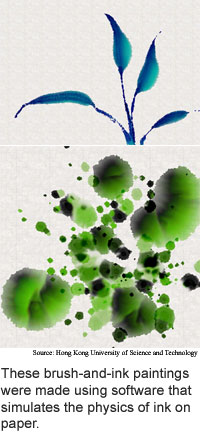
Paint program renders ink physics
Making good art with digital versions of
traditional media requires talent, inspiration and physics -- or more
precisely, accurate simulations of physics.
Although it is easy to simulate various processes on a computer,
the physics of ink flowing into an absorbent surface like paper are quite
complicated.
Researchers from the Hong Kong University of Science and Technology
have developed a brush-and-ink-style paint program, dubbed Moxi, that
uses a model of pigment particles in water flowing into paper.
The software models the gritty details of paper absorbing water
and pigment moving through through water, including the way pigment concentrates
at ink boundaries as water evaporates from drying ink. The technique promises
to make computer paint programs with more realistic and could also be
used in computer animation packages, according to the researchers.
The simulation is based on mathematics -- the lattice Boltzmann
equation -- that physicists use to model the complex behaviors of fluids.
The model simulates more complex effects than previous work, and is also
fast enough to deliver ink dispersion simulations in real-time on a reasonably
large canvas, according to the researchers.
The researchers' prototype runs on a personal computer with a
pressure-sensitive pen tablet. To turn the prototype into a commercial-grade
software package, the researchers have to make it more user-friendly and
add abilities like rendering high-resolution outputs from recorded painting
sessions, according to the researchers.
The technique could be used practically in one or two years, according
to the researchers. The researchers are scheduled to present the prototype
at the Association of Computing Machinery (ACM) Special Interest Group
Graphics (Siggraph) conference in Los Angeles July 31 to August 4, 2005.
(MoXi: Real-Time Ink Dispersion in Absorbent Paper).
Stories:
Nanowire networks route light
Cell combo yields blood vessels
Physics maps city complexity
How It Works: Self-assembly
Briefs:
Paint program renders ink physics
Silicon light switch is electric
Crystal promises more light
Micro marbles make nano rings

Research Watch blog
View from the High Ground Q&A
How It Works
RSS Feeds:
News
Ad links:
Buy an ad link
Ad links: Clear History
Buy an ad link
|
TRN
Newswire and Headline Feeds for Web sites
|
© Copyright Technology Research News, LLC 2000-2010. All rights reserved.